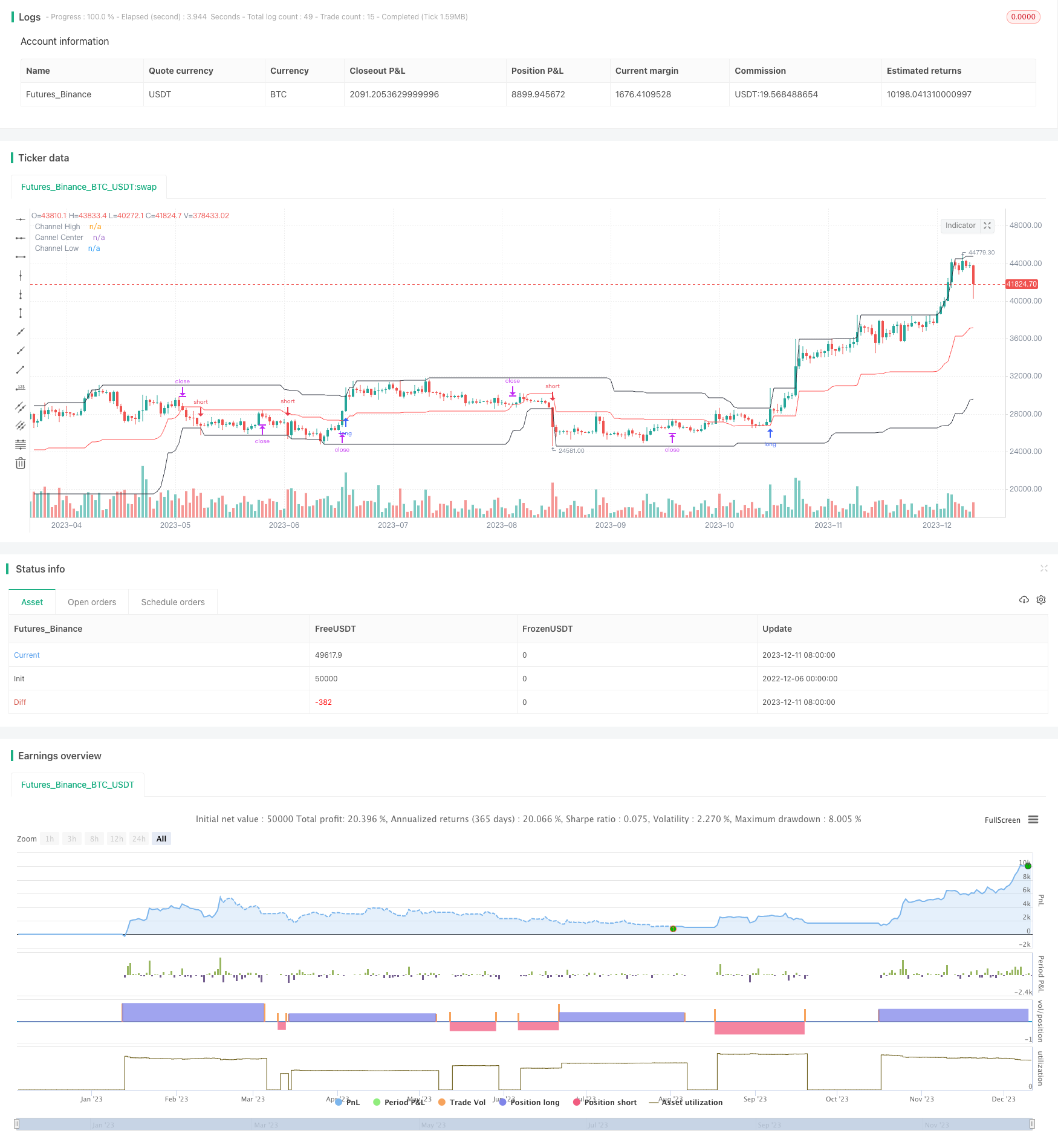
概述
动态价格通道突破策略是一种基于Donchian价格通道指标的量化交易策略。该策略根据价格通道的上限线和下限线来判断市场趋势方向,在价格突破通道时建立做多或做空仓位。
本策略的主要思想是Using breakouts of the Donchan price channel.当价格突破通道上限时,建立做多头寻求趋势;当价格跌破通道下限时,建立做空头寻求趋势。
策略原理
指标计算
价格通道由以下公式计算:
上限线 = 最高价的N周期最高值
下限线 = 最低价的N周期最低值
中线 = (上限线 + 下限线)/2
其中N代表通道周期长度,本策略中默认为50。
入场规则
当最新K线的最高价突破通道上限线时,建立做多仓位;
当最新K线的最低价跌破通道下限线时,建立做空仓位。
示例:
上一根K线高点未超过通道上限; 当前K线高点突破通道上限; ==> 建立做多仓位
出场规则
出场规则有两种可选:
- 通道出场
平多:止损价格为通道下限;
平空:止损价格为通道上限;
- 中心线出场
无论多头仓位还是空头仓位,当价格重新跌破通道中线时,平掉所有仓位。
风险控制
风险控制采用比例止损方式,根据通道幅度和设置的可承受风险百分比计算具体止损距离。
做多止损距离 = 入场价 * (1 - 可承受风险百分比)
做空止损距离 = 入场价 * (1 + 可承受风险百分比)
例如设置做多风险为2%,入场价为10,000美元,则多单止损线为10,000 * (1 - 2%) = 9,800美元。
优势分析
捕捉趋势突破
当价格突破通道上下限时,很大概率开始新的方向性趋势。这时入场可以捕捉到较大幅度的价格变动。
风险可控
采用比例止损可以将单次损失控制在可承受范围内。
参数优化空间大
通道周期长度、风险比例、止损方式等参数可以进行优化组合,适应更多市场环境。
风险分析
突破失败
价格突破通道上下限不意味着必然形成趋势,存在失败突破的概率,这时容易止损。
震荡行情
当市场处于宽幅震荡时,价格可能频繁触发通道上下限,导致过于频繁交易而增加交易费用和滑点损失。
优化方向
动态通道
可以考虑将价格通道的长度做成一个变量,根据市场波动率自动调整。市场震荡时增大通道长度,趋势明确时减小通道长度。
优化入场机会
结合其他指标过滤入场时机,例如量能指标、移动平均线等,避免在震荡行情中无效突破。
参数规整
使用更多历史数据对参数组合进行测试优化,确定最优参数以适应更广泛的市场情况。
总结
动态价格通道策略总的来说是一个较简单直观的趋势追踪策略。它的优势在于标志明确,容易掌握;风险控制比较合理。但也存在一些问题有待进一步优化,如失败突破和震荡市的处理等。本策略更适合作为趋势交易的辅助工具,和其他技术指标或模型组合使用效果会更好。
/*backtest
start: 2022-12-06 00:00:00
end: 2023-12-12 00:00:00
period: 1d
basePeriod: 1h
exchanges: [{"eid":"Futures_Binance","currency":"BTC_USDT"}]
*/
//Noro
//@version=4
strategy(title = "Noro's RiskChannel Strategy", shorttitle = "RiskChannel str", overlay = true, default_qty_type = strategy.percent_of_equity, initial_capital = 100, default_qty_value = 100, pyramiding = 0, commission_value = 0.1)
//Settings
needlong = input(true, defval = true, title = "Long")
needshort = input(true, defval = true, title = "Short")
risklong = input(2.0, minval = 0.0, maxval = 99.9, title = "Risk size for long, %")
riskshort = input(2.0, minval = 0.0, maxval = 99.9, title = "Risk size for short, %")
stoptype = input(defval = "Center", options = ["Channel", "Center"], title = "Stop-loss type")
lotsize = input(100, defval = 100, minval = 1, maxval = 10000, title = "Lot, %")
pclen = input(50, minval = 1, title = "Price Channel Length")
showll = input(true, defval = true, title = "Show lines")
showof = input(true, defval = true, title = "Show offset")
showdd = input(true, defval = true, title = "Show label (drawdown)")
showbg = input(false, defval = false, title = "Show background")
fromyear = input(1900, defval = 1900, minval = 1900, maxval = 2100, title = "From Year")
toyear = input(2100, defval = 2100, minval = 1900, maxval = 2100, title = "To Year")
frommonth = input(01, defval = 01, minval = 01, maxval = 12, title = "From Month")
tomonth = input(12, defval = 12, minval = 01, maxval = 12, title = "To Month")
fromday = input(01, defval = 01, minval = 01, maxval = 31, title = "From day")
today = input(31, defval = 31, minval = 01, maxval = 31, title = "To day")
//Price Channel
h = highest(high, pclen)
l = lowest(low, pclen)
center = (h + l) / 2
//Stop-loss
needstop = stoptype == "Center" or needlong == false or needshort == false
sl = center
//Lines
pccol = showll ? color.black : na
slcol = showll and stoptype == "Center" ? color.red : na
offset = showof ? 1 : 0
plot(h, offset = offset, color = pccol, title = "Channel High")
plot(center, offset = offset, color = slcol, title = "Cannel Center")
plot(l, offset = offset, color = pccol, title = "Channel Low")
//Background
size = strategy.position_size
bgcol = showbg == false ? na : size > 0 ? color.lime : size < 0 ? color.red : na
bgcolor(bgcol, transp = 70)
//Var
loss = 0.0
maxloss = 0.0
equity = 0.0
truetime = time > timestamp(fromyear, frommonth, fromday, 00, 00) and time < timestamp(toyear, tomonth, today, 23, 59)
//Lot size
risksizelong = -1 * risklong
risklonga = stoptype == "Center" ? ((center / h) - 1) * 100 : ((l / h) - 1) * 100
coeflong = abs(risksizelong / risklonga)
lotlong = (strategy.equity / close) * coeflong
risksizeshort = -1 * riskshort
riskshorta = stoptype == "Center" ? ((center / l) - 1) * 100 : ((h / l) - 1) * 100
coefshort = abs(risksizeshort / riskshorta)
lotshort = (strategy.equity / close) * coefshort
//Trading
if h > 0
strategy.entry("Long", strategy.long, lotlong, stop = h, when = strategy.position_size <= 0 and needlong and truetime)
strategy.entry("Short", strategy.short, lotshort, stop = l, when = strategy.position_size >= 0 and needshort and truetime)
sl := sl != 0 ? sl : size > 0 ? l : size < 0 ? h : na
if size > 0 and needstop
strategy.exit("Stop Long", "Long", stop = sl)
if size < 0 and needstop
strategy.exit("Stop Short", "Short", stop = sl)
if time > timestamp(toyear, tomonth, today, 23, 59)
strategy.close_all()
strategy.cancel("Long")
strategy.cancel("Short")
if showdd
//Drawdown
max = 0.0
max := max(strategy.equity, nz(max[1]))
dd = (strategy.equity / max - 1) * 100
min = 100.0
min := min(dd, nz(min[1]))
//Max loss size
equity := strategy.position_size == 0 ? strategy.equity : equity[1]
loss := equity < equity[1] ? ((equity / equity[1]) - 1) * 100 : 0
maxloss := min(nz(maxloss[1]), loss)
//Label
min := round(min * 100) / 100
maxloss := round(maxloss * 100) / 100
labeltext = "Drawdown: " + tostring(min) + "%" + "\nMax.loss " + tostring(maxloss) + "%"
var label la = na
label.delete(la)
tc = min > -100 ? color.white : color.red
osx = timenow + round(change(time)*10)
osy = highest(100)
// la := label.new(x = osx, y = osy, text = labeltext, xloc = xloc.bar_time, yloc = yloc.price, color = color.black, style = label.style_labelup, textcolor = tc)